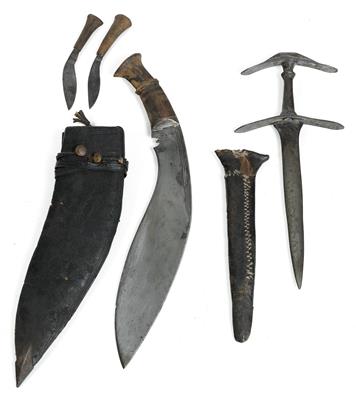Mixed lot (2 items), Afghanistan (Nuristan), Nepal: a rare dagger from Nuristan (Northeast Afghanistan) and a Kukri knife from Nepal, with two smaller accessory knives and a bag. Both objects have a sheath.
Mixed lot (2 items), Afghanistan (Nuristan), Nepal: a rare dagger from Nuristan (Northeast Afghanistan) and a Kukri knife from Nepal, with two smaller accessory knives and a bag. Both objects have a sheath.

1: A very rare dagger from Nuristan (‘Land of Light’), formerly known as Kafiristan (‘Land of the Unbelievers’). The Kafirs lived in three large valleys hidden away in the Hindu Kush mountains in North East Afghanistan. They had their own language, their own religion and their own culture. In 1895/1896 Kafiristan was conquered by the Afghan Shah Abdur Rahman. It was forcibly ‘Islamised’ and renamed Nuristan. The inhabitants lost a large part of their interesting withdrawn culture. The present dagger is a good example of a typical Kafir (today Nuristani) weapon. The relatively long, straight, double-edged blade is inserted into an iron hilt, with some remains of black colouring. This type of hilt, characteristic of Nuristan, always displays on the front of the blade, a splayed, flat ‘cross piece’ and at its rear end almost always equally wide, prominent, flat ‘wings’ on both sides. The actual hilt piece in between is round. The wood sheath is covered in black leather, stitched on the reverse side and displays an iron ‘shoe’, engraved with line decoration, at its tip (with a crack at the bottom). Overall, a rare and old object.
Length: 37 cm. 19th century.
2: A typical Kukri knife from Nepal. It has a slightly curved, single-edged blade that widens in the middle. The blade has three grooves on both sides and an inscription in Indian characters on the back. The hilt, in characteristic form, consists of hard, brown wood. It comes with two small accessory knives and a small leather pouch for flints, tinder or similar. All in a black-dyed leather sheath with embossed line decoration, a carrying strap and an iron ‘shoe’.
Length: 48 cm (in total).
First half of the 20th century. (ME)
Esperto: Prof. Erwin Melchardt
 Prof. Erwin Melchardt
Prof. Erwin Melchardt
+43-1-515 60-465
erwin.melchardt@dorotheum.at
20.02.2017 - 14:00
- Prezzo di partenza:
-
EUR 500,-
Mixed lot (2 items), Afghanistan (Nuristan), Nepal: a rare dagger from Nuristan (Northeast Afghanistan) and a Kukri knife from Nepal, with two smaller accessory knives and a bag. Both objects have a sheath.
1: A very rare dagger from Nuristan (‘Land of Light’), formerly known as Kafiristan (‘Land of the Unbelievers’). The Kafirs lived in three large valleys hidden away in the Hindu Kush mountains in North East Afghanistan. They had their own language, their own religion and their own culture. In 1895/1896 Kafiristan was conquered by the Afghan Shah Abdur Rahman. It was forcibly ‘Islamised’ and renamed Nuristan. The inhabitants lost a large part of their interesting withdrawn culture. The present dagger is a good example of a typical Kafir (today Nuristani) weapon. The relatively long, straight, double-edged blade is inserted into an iron hilt, with some remains of black colouring. This type of hilt, characteristic of Nuristan, always displays on the front of the blade, a splayed, flat ‘cross piece’ and at its rear end almost always equally wide, prominent, flat ‘wings’ on both sides. The actual hilt piece in between is round. The wood sheath is covered in black leather, stitched on the reverse side and displays an iron ‘shoe’, engraved with line decoration, at its tip (with a crack at the bottom). Overall, a rare and old object.
Length: 37 cm. 19th century.
2: A typical Kukri knife from Nepal. It has a slightly curved, single-edged blade that widens in the middle. The blade has three grooves on both sides and an inscription in Indian characters on the back. The hilt, in characteristic form, consists of hard, brown wood. It comes with two small accessory knives and a small leather pouch for flints, tinder or similar. All in a black-dyed leather sheath with embossed line decoration, a carrying strap and an iron ‘shoe’.
Length: 48 cm (in total).
First half of the 20th century. (ME)
Esperto: Prof. Erwin Melchardt
 Prof. Erwin Melchardt
Prof. Erwin Melchardt
+43-1-515 60-465
erwin.melchardt@dorotheum.at
|
Hotline dell'acquirente
lun-ven: 10.00 - 17.00
kundendienst@dorotheum.at +43 1 515 60 200 |
| Asta: | Tribal Art |
| Tipo d'asta: | Asta in sala |
| Data: | 20.02.2017 - 14:00 |
| Luogo dell'asta: | Wien | Palais Dorotheum |
| Esposizione: | 11.02. - 20.02.2017 |
